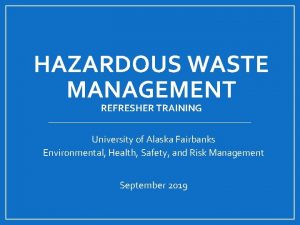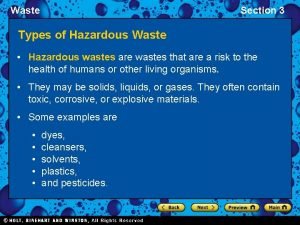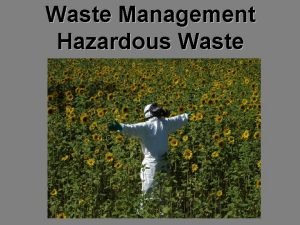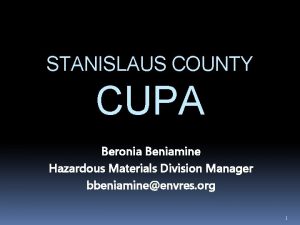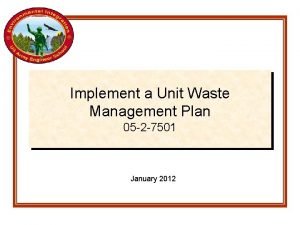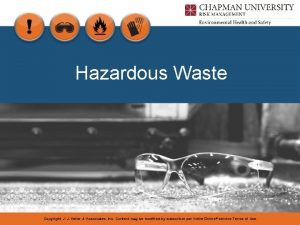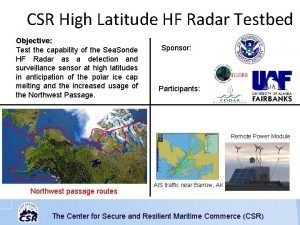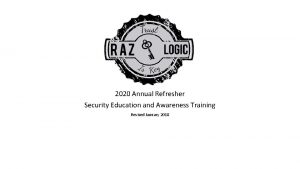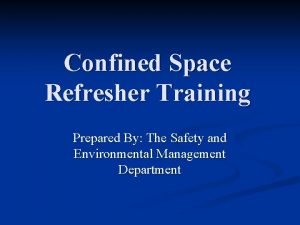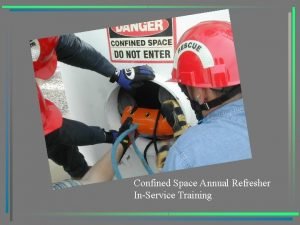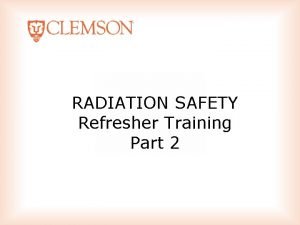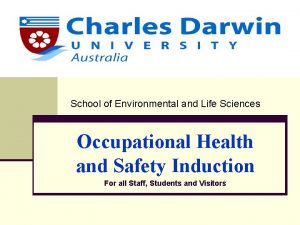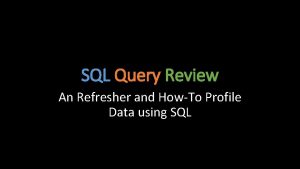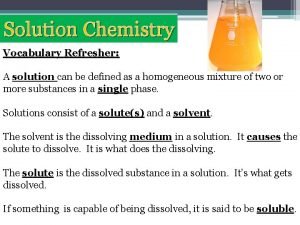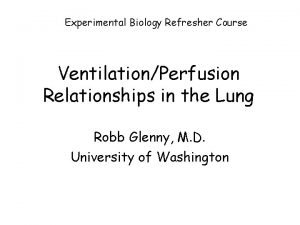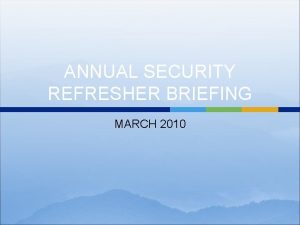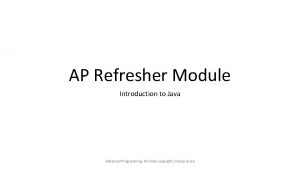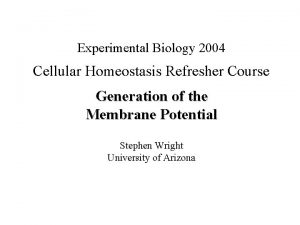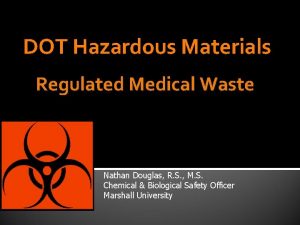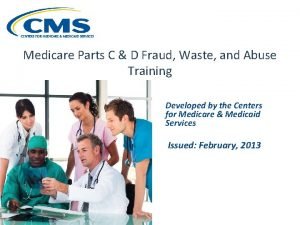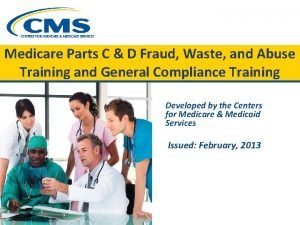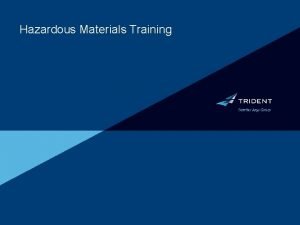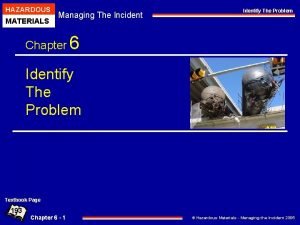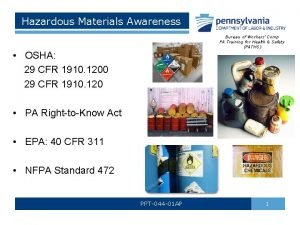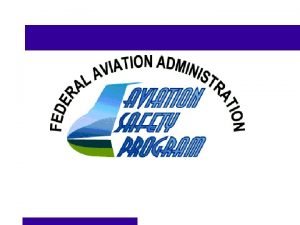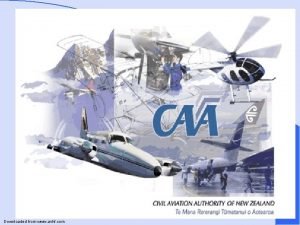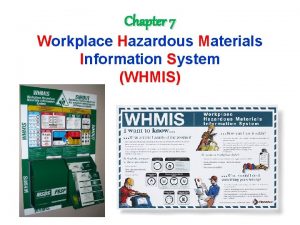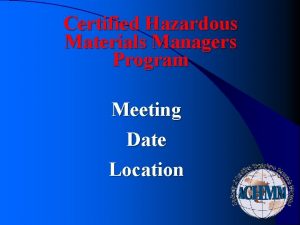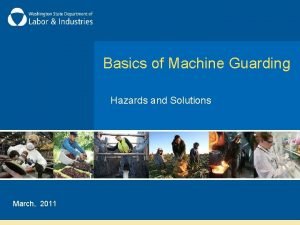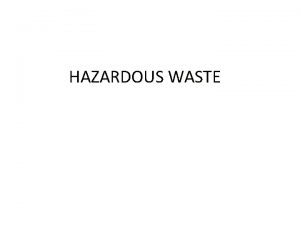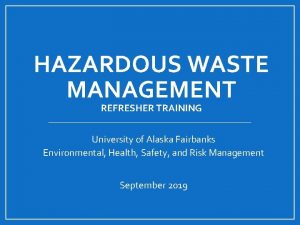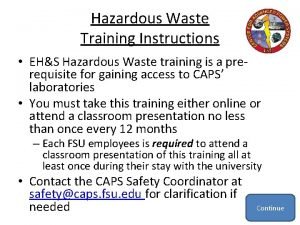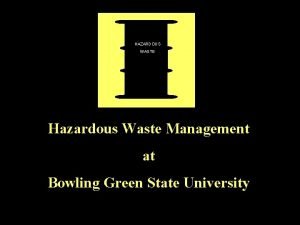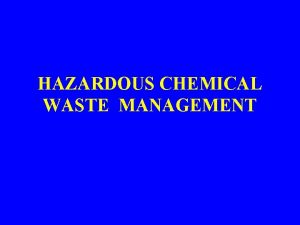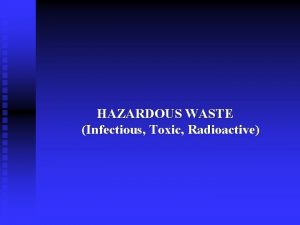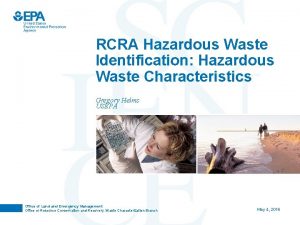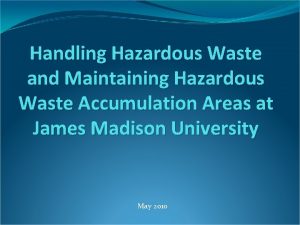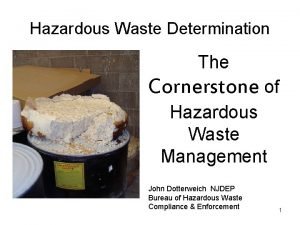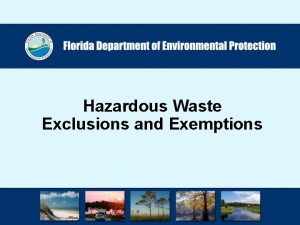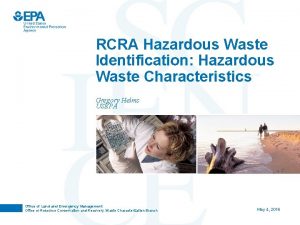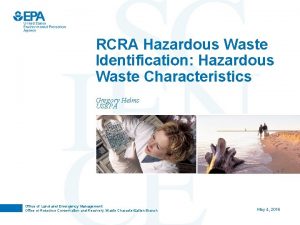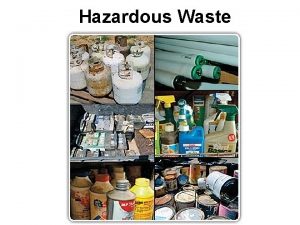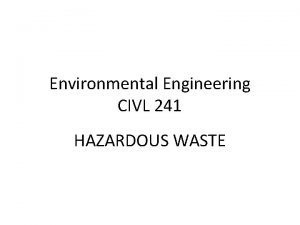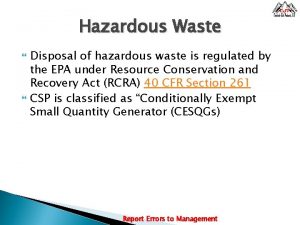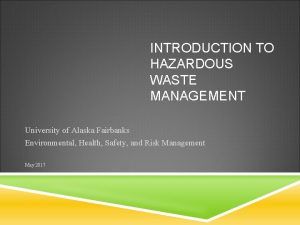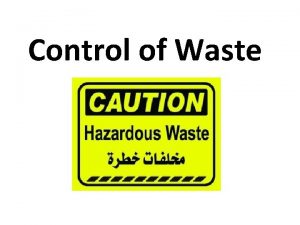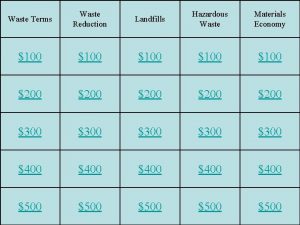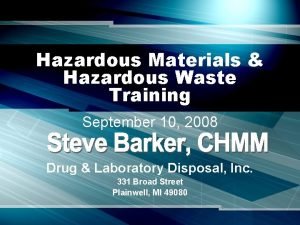HAZARDOUS WASTE MANAGEMENT REFRESHER TRAINING University of Alaska










































- Slides: 42

HAZARDOUS WASTE MANAGEMENT REFRESHER TRAINING University of Alaska Fairbanks Environmental, Health, Safety, and Risk Management September 2019

Course Outline • • • Overview of hazardous materials Hazardous waste at UAF What is hazardous waste? What do I do with my hazardous waste? Emergency response 2

Classes of hazardous materials Class 1: Explosives Class 2: Compressed Gases Class 3: Flammable Liquids Class 4: Flammable Solids Class 5: Oxidizers Class 6: Poisons and Toxics Class 7: Radioactive materials Class 8: Corrosives Class 9: Miscellaneous hazardous materials that don’t fit any other hazard class… (i. e. dry ice) 3

EPA Regulations: RCRA The Environmental Protection Agency (EPA) regulates hazardous waste in Alaska by authority of the Resource Conservation Recovery Act (RCRA). RCRA requirements include: Identification of hazardous wastes Tracking wastes from “cradle to grave” Setting standards for generators of wastes, transporters of wastes, and Treatment, Storage & Disposal Facilities 4

Training The purpose of the training is to ensure that UAF personnel who use chemicals understand how to: 1. 2. 3. 4. identify hazardous wastes (and non-hazardous wastes) package and label hazardous wastes have their hazardous materials disposed respond appropriately to emergencies Training must be completed ANNUALLY, per RCRA regulations. 5

RCRA Requirements RCRA requires that you: Receive training on hazardous waste management Identify and classify your wastes at the site of generation (i. e. , in your lab) Properly label waste containers Store only the permissible volume of waste in your lab Ensure lids and caps are securely fastened at all times Properly segregate all materials Use compatible containers Use intact containers (no cracks, holes, etc. ) Ensure that spills and overfills do not occur Ensure that mismanagement does not occur 6

UAF Hazardous Waste Management EHSRM assists UAF waste generators with waste disposal needs • Hazardous Materials Facility (HMF) stores waste and serves as UAF’s Central Accumulation Area (CAA) • RCRA-regulated hazardous wastes are shipped • Every 90 days from the HMF • By EPA-permitted transporters to EPA-permitted treatment, storage, and disposal facilities • Annual costs: $150, 000 for disposal; $400, 000 total cost of hazmat program at UAF • 7

RCRA Regulatory Inspections EPA conducts unannounced Compliance Evaluation Inspections • UAF facilities are typically inspected annually • We have recently had a number of violations and have had to pay fines. • These were nearly all violations at the site of generation (i. e. , laboratories and shops) • 8

WHAT IS HAZARDOUS WASTE? 9

Categories of waste RCRA-regulated Non-regulated, but still considered hazardous by UAF and/or Golden Heart Utilities Non-hazardous Our goal is to: 1. Comply with RCRA and other waste disposal requirements 2. Avoid unnecessary expenses associated with picking up non-hazardous and non-regulated wastes 10

Is your waste a hazardous waste? EPA regulations (40 CFR 261. 2) require that a hazardous waste determination be made at the point of waste generation • • This means that it has to be made by the person(s) generating the waste at their lab, shop, or studio. 11

Categories of waste RCRA identifies three main kinds of wastes: 1. Listed wastes P list, U list F and K lists (not typical in labs) 2. Characteristic wastes D list TCLP (toxic characteristic leaching procedure; not typical in labs) 3. Universal wastes Batteries, light bulbs 12

Listed Wastes U-listed wastes are toxic wastes • P-listed wastes are acutely toxic wastes • F-listed wastes are from non-specific sources • Example: halogenated solvents used to degrease equipment • • K-listed wastes are from specific sources • Example: petroleum refining or pesticide manufacturing 13

Examples of U-Listed Wastes (toxic) Acetaldehyde Acetonitrile Aniline Benzene Bromoform 1 -Butanol Chloroform 1, 4 -Dioxane Ethyl acetate Ethyl ether Formaldehyde Methyl alcohol Methylene chloride Phenol Toluene U-listed chemicals are common in UAF labs 14

Examples of P-Listed Wastes (acutely toxic) Allyl alcohol Ammonium vanadate Arsenic acid Arsenic trioxide Carbon disulfide 2, 4 -Dinitrophenol Fluorine Nitric oxide Osmium tetroxide Phenylthiourea Potassium cyanide Sodium azide Sodium cyanide Thiosemicarbazide Vanadium oxide Vanadium pentoxide P-listed chemicals are also fairly common in UAF labs 15

Characteristic Wastes D 001 – Ignitable Wastes (flashpoint is less than 140º F); includes oxidizers • D 002 – Corrosive Wastes (p. H ≤ 2 or ≥ 12. 5) • D 003 – Reactive Wastes (water reactive, normally unstable materials, cyanides, sulfides, etc. ) • D 004 – TCLP Wastes • 16

Examples of common lab hazardous chemical wastes • Ethanol (25 -100%) • • Ethanol at <25% is not regulated Acetone (25 -100%) • Acetone at <25% is not regulated 3. 7% formalin (a. k. a. 10% formalin) • Nitric acid (all concentrations) • 10% hydrochloric acid bath solution (but see later) • 17

Examples of common lab nonhazardous liquid wastes PBS (phosphate buffered saline) • Tris buffer • Many components of Qiagen kits (except the ones with ethanol added to >24%) • Anything that is not flammable, corrosive, toxic, or oxidizing • 18

Examples of hazardous and nonhazardous solid wastes NON-HAZARDOUS Pipet tips that were used for ethanol, chloroform, acetone, etc. Microfuge tubes that formerly contained ethanol, acetone, etc. Empty containers of hazardous and non-hazardous chemicals, except those that contained Plisted chemicals HAZARDOUS Pipet tips that were used for toxic compounds (i. e. , arsenic, mercury, lead, cadmium), etc. Microfuge tubes that formerly contained solutions of arsenic, mercuric chloride, cadmium solutions, etc. 19

Handling of non-hazardous wastes Throw used pipet tips and microfuge tubes in the regular trash. Triple-rinse empty containers and drain the rinse water down the sink. Write “empty” on the container and throw it away… or use to collect truly hazardous wastes (after labeling properly) Tripe-rinse and air dry glass bottles. Remove the label or cover it. Put on a new label and use it to collect truly hazardous waste solutions. Mildly acidic solutions with no other hazard: carefully add baking soda to neutralize. Check the p. H and put down the sink if the p. H is between 6 and 8. 20

Segregation and handling of hazardous and non-hazardous wastes NON-HAZARDOUS Discard in the regular trash or down the sink. Please DO NOT request a waste pickup of these items. HAZARDOUS Collect in a suitable, labeled container with a closed lid, or in a labeled bag (for solid wastes). When the container is full or you no longer generate the waste, go online and make a waste pickup request. 21

Universal Wastes • Universal wastes include the following materials that are commonly found in the workplace Batteries • Fluorescent lamps • Pesticides • Thermometers (containing mercury) • 22

Universal Wastes: Batteries Used Battery collection containers (white 5 gallon buckets) are available at many locations on campus • Contact your Lab Manager, CHO, Shop Supervisor or EHSRM for more information • 23

Universal Wastes: Mercury Thermometers If you break a mercury thermometer: DO NOT try to clean it up yourself ---- Call UAF Hazmat at 474 -5617 immediately for assistance Evacuate the area and keep traffic from walking through the spill site NEVER throw the material in the trash or dump it down the drain 24

Other Wastes: Aerosol Cans Aerosol cans are considered hazardous waste under the definition of “Characteristic Reactivity” Often contain hazardous materials, either as the product or as the propellant Most aerosol cans, regardless of contents, can never be completely emptied of propellant Aerosol cans become a waste when… their contents are used up, malfunction (i. e. fail to spray), or when the contents are no longer needed 25

WASTE IN YOUR LAB What do I do with my wastes and unwanted chemicals? 26

Satellite Accumulation Areas Each lab that generates waste is referred to as a “Satellite Accumulation Area” (SAA) A generator may accumulate hazardous waste in containers at or near any point of generation where wastes initially accumulate which is under the control of the operator of the process generating the waste When EHSRM removes the waste from a SAA, it is transferred to the UAF Hazmat Facility or “Central Accumulation Area” 27

Waste Storage Limits for SAAs For SAAs, the waste storage limits are: Up to 55 gallons of non-acute hazardous waste • Up to 1 quart (liquid) or 1 kg (solid) of an acute hazardous waste (P-listed waste) • But note: 50 gallons of waste at a SAA will likely be in violation of Fire & Building Codes 28

SAA container Management A container holding hazardous waste must be closed at all times during accumulation, except: when adding, removing, or consolidating waste; or when temporary venting of a container is necessary for the properation of equipment, or to prevent dangerous situations, such as build-up of extreme pressure. 29

SAA container Management (cont. ) A generator must mark or label a container holding hazardous waste with the following: The words “Hazardous Waste” The full name and concentration of the contents, and A description of the hazard(s) of the contents Examples: corrosive, reactive, toxic, flammable A hazard statement or pictogram consistent with the OSHA Hazard Communication Standard or a chemical hazard label consistent with the National Fire Protection Association may also be used. 30

To Make a Waste Removal Request As of April 2012, the Division of Hazardous Materials at EHSRM is using an online hazardous waste pick up request. Please discontinue using the old triplicate paper hazardous waste transfer request forms. If you have not been trained in the use of the online request, call 474 -7889 to schedule a training session. Or go to the EHSRM website for more information: http: //www. uaf. edu/safety/laboratory-safety/chemical-inventory/ Remember: There is no charge to your lab for chemical waste disposal 31

TAKE-HOME MESSAGES What you need to remember… 32

Wastes: Containers and Storage Only use containers that are compatible with the materials to be collected Always label containers with a description of their contents and their hazard(s) Don’t store incompatible materials together Do not store wastes in the fume hood. Store in the appropriate storage cabinet (e. g. , flammable, acid) Provide secondary containment for liquid wastes Always keep the container closed (lid firmly secured) A funnel in an open bottle is NOT a lid Check waste storage areas regularly (weekly). Inspect containers to make sure they aren’t getting brittle or starting to crack 33

Before You Start a Project Plan ahead Is there a product or procedure available that will accomplish the task without generating a hazardous waste? Strive for waste minimization Only make as much solution as you need Substitute less hazardous chemicals if possible Use microscale chemistry techniques Before purchasing chemicals, log onto your EHS Assistant online inventory and click on the “Surplus Chemicals” button at the top of the main page. Contact EHSRM at 474 -5617 to request transfer of surplus chemicals. 34

Other Things to Think About Check the P-list - if you plan to use a P-listed chemical, contact your Chemical Hygiene Officer, Lab Manager or EHSRM Never combine wastes If you don’t generate them together as part of a procedure, then do not mix them. May create hazardous reactions in the bottle (worst-case scenario), or make it more expensive for us to dispose of it (not a good scenario, but at least it didn’t blow up) 35

EMERGENCY RESPONSE 36

Spills of Hazardous Chemicals Report all spills of hazardous chemicals to UAF EHSRM Hazmat (474 -5617 or 474 -6771) • Call 911 if there is an immediate threat of harm to life or property • If no one can be reached, call UAF Dispatch and they will locate EHSRM staff. If you have not been trained and/or do not have the appropriate personnel protective equipment, please call for assistance! 37

Spills of Hazardous Chemicals (cont. ) If the spill is a solvent and more than 1 L is spilled, then everyone should vacate the lab and call EHSRM for assistance. • Flammable vapors evaporating from the spill can create a fire hazard. If the spill is an acid, and more than 250 -500 m. L is spilled, everyone should vacate the lab and call EHSRM for assistance. • Acid vapors are very corrosive to respiratory and eye tissues and may cause injury, pulmonary edema, etc. 38

Spills of Hazardous Chemicals (cont. ) Alert others to stay clear of the area • Inform emergency responders what has been spilled and what the hazard is (flammable, corrosive, toxic, etc. ) • they need to know if it is safe to go in without their respirators! • Remember, chemical labs are under negative pressure, so there is more air exiting the lab through the ventilation system than there is coming in through the supply duct • This helps keep hazardous vapors in the lab, rather than resulting in their escape into the hallways. • Evacuating the lab and closing the door will help protect you and others. • 39

Emergency Procedures: Evacuation In the event of a fire or earthquake, you may need to evacuate the building. You should: • Know the evacuation procedures and evacuation route information for your area • Evacuate the building using the nearest safe exit • Do not use elevators! • Take personnel belongings (keys, purses etc. , but don’t put yourself or others at risk by delaying evacuation) • If possible, secure any hazardous materials or equipment 40

Emergency Procedures: Evacuation (cont. ) Follow any directions given by emergency personnel Go to Evacuation Assembly Points (EAPs) designated on the emergency evacuation sign for the building This information is in your building’s Emergency Action Plan (EAP), which must be reviewed annually for every building that you work in. Assist persons with disabilities Do not leave the area/campus until your status has been reported to your supervisor or building coordinator 41

For More Information… Environmental, Health, Safety, and Risk Management Visit our website at: www. uaf. edu/safety Or call us at 474 -5413 42
 Alaska hazmat training
Alaska hazmat training Section 3 hazardous waste answers
Section 3 hazardous waste answers Screw feed technology of waste management
Screw feed technology of waste management E-waste definition apes
E-waste definition apes Hazardous waste examples
Hazardous waste examples Stanislaus county hazardous waste
Stanislaus county hazardous waste Waste management references
Waste management references Solid and hazardous waste
Solid and hazardous waste Keller hazardous waste disposal
Keller hazardous waste disposal High latitude range management training alaska
High latitude range management training alaska Gdpr refresher training
Gdpr refresher training Annual security refresher training
Annual security refresher training Confined space refresher
Confined space refresher Confined space refresher training
Confined space refresher training Refresher training example
Refresher training example Refresher training example
Refresher training example Hazardous area training darwin
Hazardous area training darwin Admissions uaf
Admissions uaf Uaf book store
Uaf book store Sql refresher
Sql refresher Chemistry molarity
Chemistry molarity What is v/q mismatch
What is v/q mismatch Annual security refresher
Annual security refresher Stream exercises java
Stream exercises java Java refresher course
Java refresher course Ipv refresher course
Ipv refresher course Red helmet training
Red helmet training Ifr refresher
Ifr refresher Saeta refresher course 2021
Saeta refresher course 2021 Biology refresher
Biology refresher Dot regulated medical waste training
Dot regulated medical waste training Fraud waste and abuse training answers
Fraud waste and abuse training answers Fraud waste and abuse training answers
Fraud waste and abuse training answers Aviation hazardous attitudes
Aviation hazardous attitudes What is hazardous material
What is hazardous material Hazardous materials table
Hazardous materials table Hazardous
Hazardous Pa-psfa-hazardous materials awareness
Pa-psfa-hazardous materials awareness Avhf
Avhf Avhf
Avhf Shape and color of whmis 2015 symbols
Shape and color of whmis 2015 symbols Chmm accreditation training
Chmm accreditation training In running nip points
In running nip points
